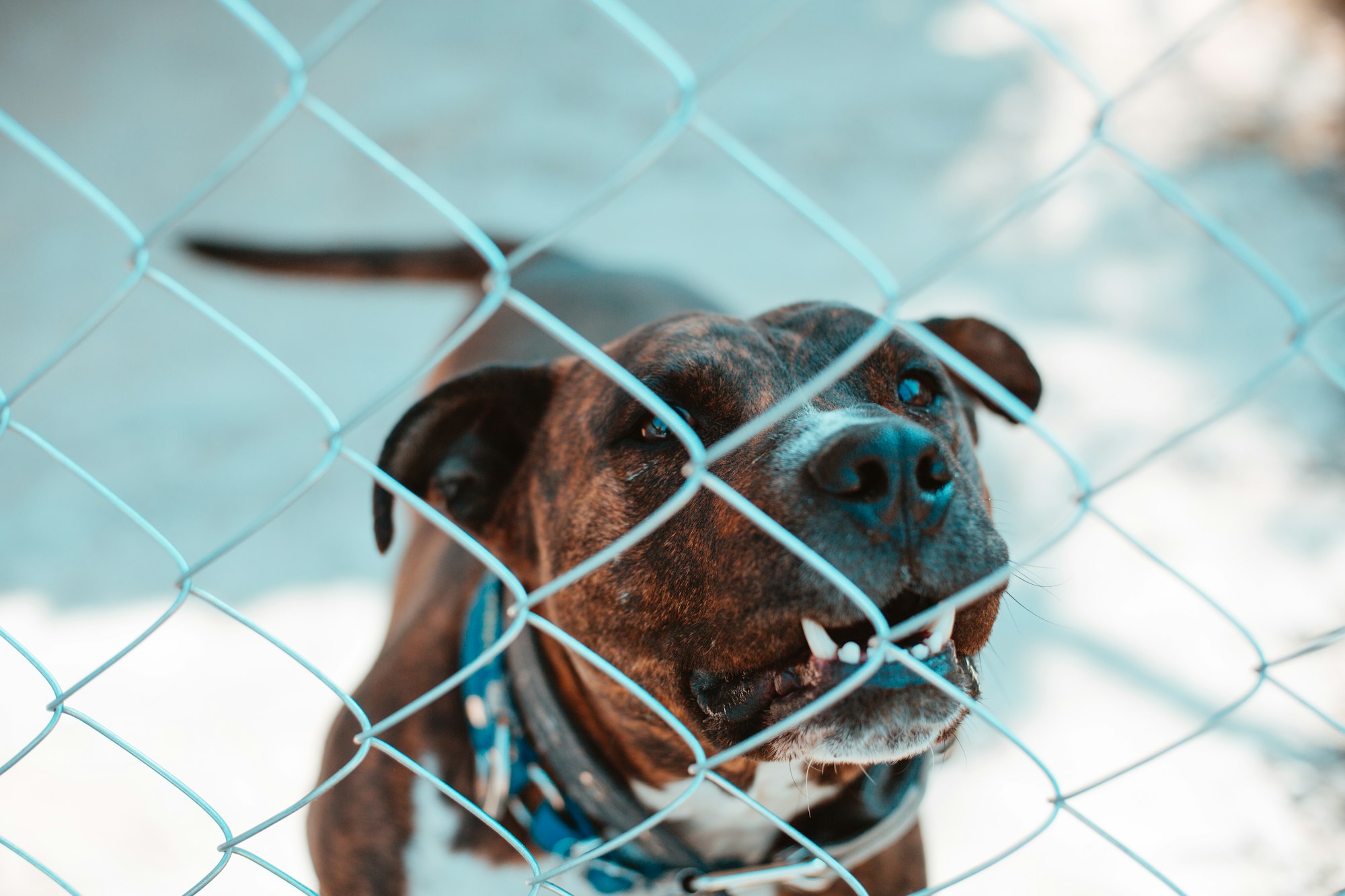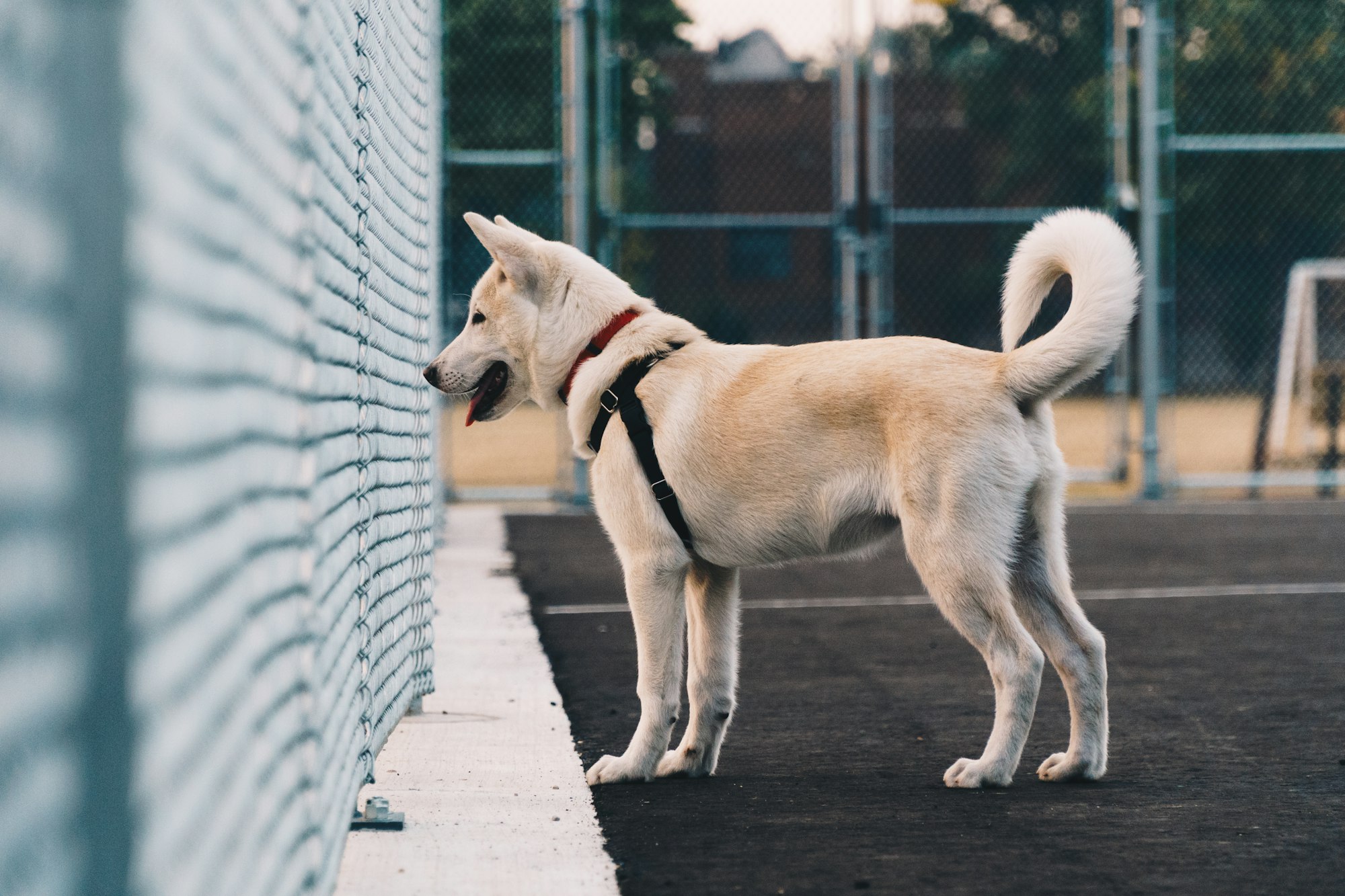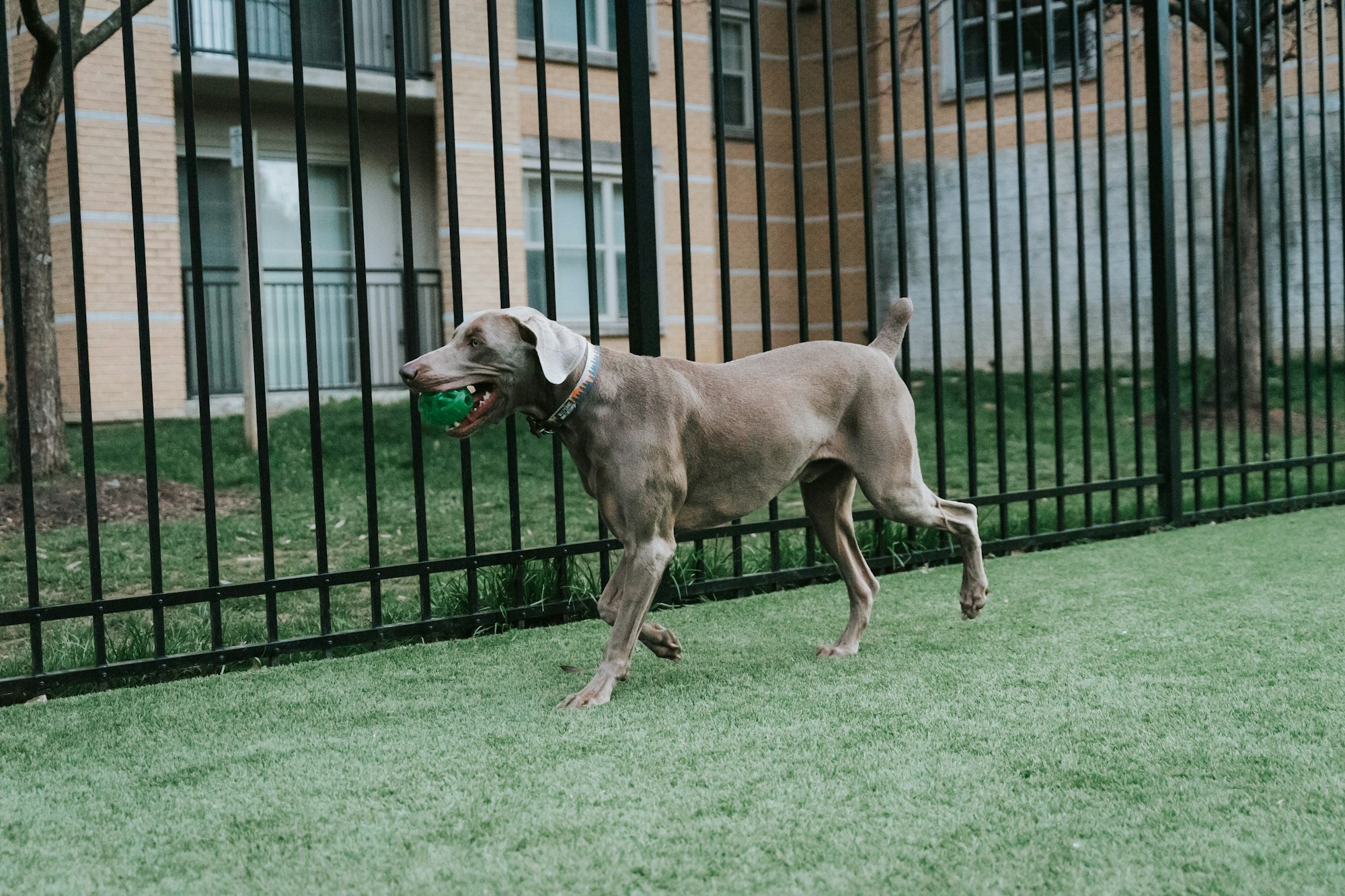Dog fence aggression is a common issue that many dog owners face. It occurs when a dog becomes aggressive or anxious when they are near or around a fence. This behavior can be dangerous for both the dog and anyone who may be near them.

There are many reasons why a dog may exhibit fence aggression. Some dogs may feel territorial and become protective of their space. Others may become anxious or frustrated when they are unable to reach something or someone on the other side of the fence. Additionally, dogs may become aggressive when they feel threatened or intimidated by people or other animals outside of the fence.
Understanding the reasons behind dog fence aggression is important in order to properly address the issue. In this article, we will explore the causes of fence aggression, as well as provide tips and strategies for owners to help their dogs overcome this behavior. By taking proactive steps to address fence aggression, owners can help ensure the safety and well-being of their dogs and those around them.
Understanding Dog Fence Aggression
Defining Fence Aggression
Fence aggression, also known as barrier frustration or barrier aggression, is a type of aggression that dogs exhibit when they are confined by a physical barrier such as a fence or a window. This type of aggression is often triggered by the presence of a neighboring dog, a passing vehicle, or any other stimulus that the dog perceives as a threat.
Common Triggers and Stimuli
Dogs that suffer from fence aggression are often triggered by certain stimuli such as the sound of a barking dog, the sight of a passing vehicle, or the presence of a neighboring dog. These triggers can cause the dog to become anxious and stressed, which can lead to aggressive behavior.
Psychology Behind the Behavior
The behavior of fence aggression is rooted in the psychology of the dog. When a dog is confined by a physical barrier, it can feel trapped and vulnerable. This feeling of vulnerability can cause the dog to become anxious and stressed, which can lead to aggressive behavior.
Differences in Dog Breeds and Personalities
The behavior of fence aggression can vary depending on the breed and personality of the dog. Some breeds are more prone to this type of behavior than others, and some dogs may have a more dominant personality that can exacerbate the behavior.
Impact of Environment on Behavior
The environment in which a dog lives can also have an impact on its behavior. Dogs that are exposed to loud noises or other stressful stimuli on a regular basis may be more prone to fence aggression than dogs that live in a quieter environment.
Recognizing Signs of Aggression
It is important for dog owners to be able to recognize the signs of fence aggression in their dogs. These signs can include barking, growling, and lunging at the fence or window. If left untreated, this behavior can escalate and become a serious safety concern for both the dog and its owner.
In conclusion, understanding the behavior of fence aggression is important for dog owners to ensure the safety and well-being of their pets. By recognizing the triggers and signs of this behavior, owners can take steps to prevent and manage it in their dogs.
Prevention and Management Strategies
Importance of Early Training
One of the most effective ways to prevent dog fence aggression is through early training. Basic obedience training should be started as soon as possible to establish commands such as "sit," "stay," and "settle." This training should be reinforced regularly to ensure that the dog understands and follows these commands.
Creating a Calm Environment
Dogs that are stressed or anxious are more likely to exhibit fence aggression. It is important to create a calm environment for the dog by providing a comfortable living space, regular exercise, and plenty of mental stimulation. This can include activities such as puzzle toys or interactive games.
Proper Use of Barriers and Fences
Visual barriers such as curtains, tarps, or privacy fences can be effective in reducing fence aggression. Physical barriers such as chain link or wooden fences with slats or FRP can also be used. However, it is important to ensure that these barriers are properly installed and maintained to prevent escape or injury.
Introducing Management Tools
Management tools such as a leash or long line can be used to prevent the dog from reaching the fence and exhibiting aggression. An airlock can also be used to prevent the dog from escaping through the front door when visitors arrive.
Avoiding Punishment Techniques
Punishment techniques such as shock collars or physical reprimands should be avoided as they can increase stress and anxiety in the dog. Instead, positive reinforcement should be used to encourage good behavior.
Implementing Routine and Structure
Dogs thrive on routine and structure, and this can be particularly important in preventing fence aggression. Regular walks, meal times, and play sessions can help to establish a routine for the dog and reduce stress and anxiety.
By implementing these prevention and management strategies, dog owners can effectively reduce the likelihood of fence aggression and create a safe and comfortable environment for their pets.
Training Techniques to Reduce Aggression
Dog fence aggression can be a serious problem, but there are many training techniques that can help reduce it. Here are some effective strategies for reducing aggression in dogs:
Basic Obedience and Commands
Basic obedience training is essential for all dogs, but it can be especially important for dogs with fence aggression. Commands such as "sit," "stay," and "come" can help you control your dog's behavior and prevent him from becoming too excited or aggressive when he's near the fence.
Leash and Recall Training
Leash training and recall training can also be helpful for reducing fence aggression. By teaching your dog to walk calmly on a leash and come when called, you can prevent him from getting too close to the fence and becoming overexcited.
Counter-Conditioning and Desensitization
Counter-conditioning and desensitization techniques can help your dog learn to associate the fence with positive experiences rather than negative ones. This can involve exposing your dog to the fence in a controlled environment and rewarding him with high-value treats when he remains calm and relaxed.
Redirecting Negative Behavior
Redirecting your dog's negative behavior can also be effective in reducing fence aggression. This can involve distracting your dog with a toy or treat when he becomes too excited or aggressive near the fence.
Professional Training and Behavior Modification

If your dog's fence aggression is severe, you may want to consider working with a professional dog trainer or behaviorist. They can help you develop a customized training plan that addresses your dog's specific needs and behavior issues.
Consistency and Patience in Training
Finally, it's important to be patient and consistent in your training efforts. Changing your dog's behavior takes time and effort, but with the right training techniques and a lot of patience, you can help your dog overcome his fence aggression and become a well-behaved and happy companion.
Solutions for Specific Fence Types
Enhancing Chain Link and Wooden Fences
Chain link and wooden fences are the most commonly used types of fences for dog owners. However, they are not always effective in preventing dog fence aggression. To enhance these types of fences, the following solutions can be used:
- Adding slats to chain link fences: Slats can make the fence look more solid and less transparent, which can help reduce a dog's visual stimulation and prevent fence aggression.
- Using a privacy fence: A privacy fence is a type of fence that provides a visual barrier between the dog and the outside world. This type of fence can be made of wood, vinyl, or other materials and can be installed to provide complete privacy.
Using Privacy Solutions Effectively
Privacy solutions can be an effective way to prevent dog fence aggression. Here are some tips on how to use them effectively:
- Use tarps: Tarps can be used to cover the fence and provide a visual barrier between the dog and the outside world. They are affordable and easy to install.
- Use airlocks: An airlock is a small enclosed area that is installed on both sides of the fence. This allows the dog to enter and exit the yard without coming into contact with people or other animals.
Alternatives to Traditional Fencing
If traditional fencing is not an option, there are alternative solutions that can be used to prevent dog fence aggression. Some of these solutions include:
- Invisible fences: Invisible fences use a radio signal to create a boundary around the yard. When the dog gets too close to the boundary, they receive a mild electric shock. This can be an effective way to prevent fence aggression, but it does require training.
- Outdoor enclosures: Outdoor enclosures are a type of dog run that can be installed in the yard. They provide a safe and secure area for the dog to play and relax without the risk of fence aggression.
By using these solutions, dog owners can prevent fence aggression and ensure their dogs are safe and secure in their yards.
When to Seek Professional Help
Dog fence aggression can be a serious issue that requires professional help. While some cases can be resolved with training and behavior modification techniques, others may require the assistance of a professional dog trainer or behavior specialist.
Identifying the Need for a Dog Trainer
If a dog is exhibiting signs of aggression towards people or other animals, it is important to seek the help of a professional dog trainer. A professional dog trainer can help identify the underlying cause of the aggression and develop a training plan to address the behavior.
Working With Behavior Specialists
In some cases, a dog may require the assistance of a behavior specialist to address their aggression. Behavior specialists are trained to work with dogs that have more severe behavioral issues, such as anxiety or stress-related aggression.
Utilizing Resources and Support Networks
There are many resources and support networks available to help dog owners address their pet's aggression. The ASPCA offers a wealth of information on dog behavior and training, as well as a directory of professional dog trainers and behavior specialists.
Overall, it is important to seek professional help if a dog is exhibiting aggression towards people or other animals. With the help of a professional dog trainer or behavior specialist, it is possible to address the underlying causes of the aggression and develop a plan to modify the behavior.
Living with a Reactive Dog
Living with a reactive dog can be challenging, but with proper management and coping strategies, it is possible to provide a safe and happy home for both the dog and the owner. Daily management of aggression, coping strategies for owners, safe interaction with guests and strangers, and building a supportive community are essential components of living with a reactive dog.
Daily Management of Aggression
Managing a reactive dog involves reducing stress triggers and preventing situations that may lead to aggressive behavior. Owners should identify stress triggers and avoid them whenever possible. For instance, if the dog is reactive to neighboring dogs, owners can avoid walking the dog in areas where there are many other dogs. Barrier reactivity, such as fence aggression, can be managed by blocking the dog's view of the outside world or using a solid fence.
Coping Strategies for Owners
Living with a reactive dog can be stressful for the owner. Coping strategies such as exercise, relaxation techniques, and seeking support from friends and family can help reduce stress levels. Owners should also seek professional help from a veterinarian or a certified dog behaviorist to develop a behavior modification plan for the dog.
Safe Interaction with Guests and Strangers
Owners should inform guests and strangers about the dog's reactive behavior and provide guidelines for safe interaction. Guests should be instructed not to approach the dog and to avoid making direct eye contact. Owners can also use visual cues such as a yellow ribbon or a "caution" vest to alert others to the dog's reactive behavior.
Building a Supportive Community
Building a supportive community is essential for owners of reactive dogs. Owners can join support groups or attend training classes to learn from other owners and professionals. A supportive community can provide emotional support, practical advice, and a sense of belonging.
In conclusion, living with a reactive dog requires proper management, coping strategies, safe interaction with guests and strangers, and building a supportive community. With patience, dedication, and professional help, owners can provide a safe and happy home for their reactive dog.
Long-Term Outlook and Adaptation
Understanding the Prognosis of Fence Aggression
Fence aggression in dogs can be a challenging behavior to manage, but it is not a hopeless situation. The long-term outlook for dogs with fence aggression depends on the severity of the behavior and the owner's commitment to managing it. In some cases, dogs may need lifelong management to prevent aggressive outbursts.
It's essential to understand that fence aggression is a learned behavior that can be unlearned with proper training and management. The prognosis for a dog with fence aggression will depend on the dog's age, breed, temperament, and the underlying cause of the behavior.
Adapting Lifestyle to Accommodate Behavior
Owners must adapt their lifestyle to accommodate the dog's behavior. This includes providing a routine and structured lifestyle for the dog, which can help reduce anxiety and stress. Dogs with fence aggression benefit from a predictable routine, regular exercise, and mental stimulation.
Owners should also consider management strategies such as blocking the dog's view of the fence, providing a designated area for the dog to play, and avoiding triggering situations. It's essential to create a safe and secure environment for the dog to prevent aggressive outbursts.
Continued Training and Reinforcement
Training is an essential component of managing fence aggression in dogs. Owners must work with a professional trainer to develop a training plan that addresses the dog's specific behavior. The training plan should include positive reinforcement training, counter-conditioning, and desensitization techniques.
Commands such as "leave it" and "come" can be helpful in redirecting the dog's attention away from the fence. It's crucial to reinforce positive behavior consistently and avoid punishing the dog for aggressive behavior.
In conclusion, dogs with fence aggression can lead happy and fulfilling lives with proper management and training. Owners must be committed to adapting their lifestyle and providing a safe and secure environment for their dog. With continued training and reinforcement, dogs can unlearn fence aggression and develop positive behaviors.
Frequently Asked Questions

- Q1: How can I prevent my dog from displaying aggression at the fence line?
- To prevent your dog from displaying aggression at the fence line, it is important to properly socialize and train your dog. Gradual exposure to different environments and positive reinforcement training can help reduce anxiety and reactivity. Additionally, providing your dog with plenty of exercise and mental stimulation can help decrease their overall stress levels.
- Q2: What are effective methods to reduce barrier aggression in dogs?
- Effective methods to reduce barrier aggression in dogs include desensitization and counterconditioning, which involve gradually exposing your dog to the fence line and rewarding them for calm behavior. Other methods include providing your dog with distractions, such as toys or treats, when they are near the fence line and using visual barriers, such as privacy screens or landscaping.
- Q3: What strategies can deter neighbor's dogs from approaching my fence?
- Strategies to deter neighbor's dogs from approaching your fence include installing a physical barrier, such as a fence to prevent direct contact, and using deterrents such as motion-activated sprinklers or ultrasonic devices. Additionally, it is important to communicate with your neighbors and work together to address any issues.
- Q4: Are there any sprays or deterrents that can prevent dogs from getting too close to a fence?
- There are sprays and deterrents available that can help prevent dogs from getting too close to a fence. These include bitter-tasting sprays, which can be applied to the fence line, and ultrasonic devices, which emit a high-pitched sound that dogs find unpleasant.
- Q5: What training techniques can be used to address a dog's reactivity to fences?
- Training techniques that can be used to address a dog's reactivity to fences include positive reinforcement training, desensitization and counterconditioning, and behavior modification techniques. It is important to work with a professional trainer or behaviorist to determine the best approach for your dog.
- Q6: How can I safely manage interactions between my dog and other dogs at the fence?
- To safely manage interactions between your dog and other dogs at the fence, it is important to supervise all interactions and intervene if necessary. Providing your dog with distractions, such as toys or treats, can also help redirect their attention away from other dogs. Additionally, using visual barriers or scheduling playdates with known friendly dogs can help reduce the likelihood of negative interactions.